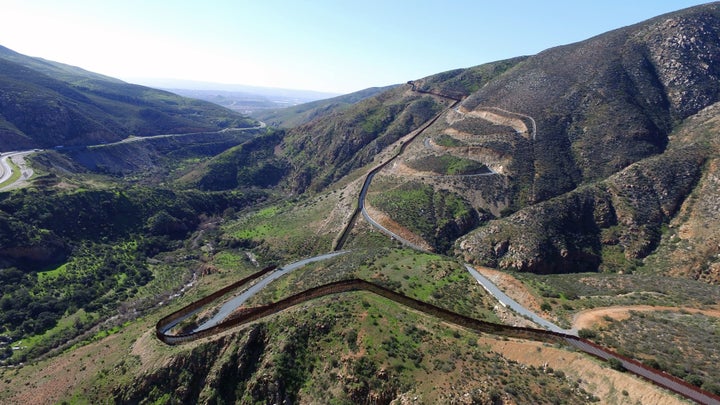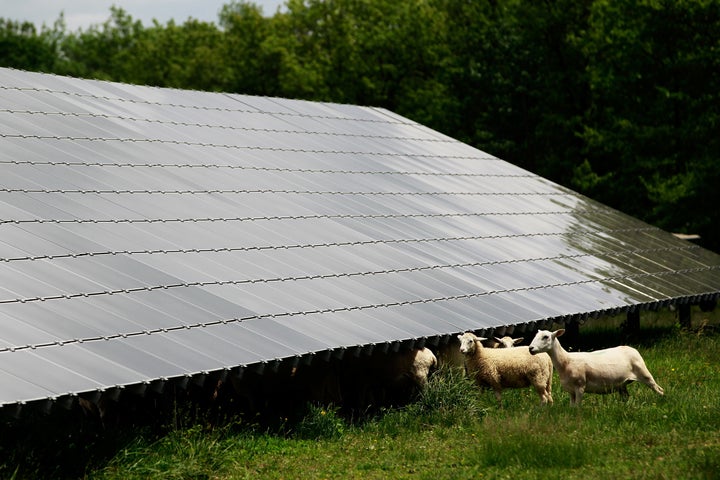
MEXICO CITY — On June 21, President Donald Trump told a rally in Iowa about his new idea for adding solar panels to the wall he wants to build on the U.S.-Mexico border. As many news reports pointed out, we had proposed a “border of solar panels” in a December op-ed in The WorldPost that had more than one million social interactions. Although we are encouraged that the president has drawn further attention to the colossal potential of solar energy in the U.S.-Mexico border region, we wish to clarify that our vision is fundamentally different from Trump’s — and much more rewarding.
Rather than a concrete slab with a coating of solar panels, we propose building a conventional — but vast — series of solar parks along the Mexican side of the border: a “solar border.” Instead of wasting around $70 billion on a wall that would be an ecological nightmare and easily traversed in two minutes with a handmade ladder and a rope, the solar parks we propose would create a different kind of structure between the countries, one funded by private investors that would capitalize on some of the best sunlight territory on the planet. This approach would provide copious benefits.
“Our vision is fundamentally different from Trump's — and much more rewarding.”
1. Affordable clean energy could power the cities and industries near the border and also, with the help of low-loss, high-voltage transmission lines, distant areas across North America, with an environmental footprint minuscule by comparison to fossil fuel plants of the same capacity.
2. A massive, long-term infrastructure program would provide thousands of jobs, many of them high-skilled, to potential border crossers.
3. A physical obstacle equipped with sensors and other security measures would offer an effective way to impede the illegal traffic of drugs, arms and people across the border.
4. Solar-powered desalination plants would provide freshwater for desert and agricultural areas that will be ever-more desiccated as the planet warms.
5. Enough renewable energy would make an impressive contribution toward reducing global warming, one that could enable both Mexico and the U.S. to significantly exceed their original commitments under the Paris climate change accord.
6. Unlike a wall, such a border would be a shining symbol of shared purpose and comity among neighboring nations and a model for other states of the world to emulate.
“Building a strip of solar parks along the Mexican side of the border would be paid for not by taxpayers of either country but by private investors.”
Solar parks, in contrast to walls with solar panels, can produce vast amounts of clean energy with comparatively minimal environmental impact, and they actually do pay for themselves relatively quickly. That’s why, as Mexican Energy Secretary Pedro Joaquin Coldwell said earlier this year, dozens of companies have invested more than $6.5 billion in solar and wind parks in Mexico in the past year, at record-breaking low costs for consumers. These companies and others are expected to bid another $4 billion before November. If Mexico can raise over $10 billion in two years for renewable energy in parts of its territory, it stands to reason it could do the same along its northern border, especially since that energy could be sold either to Mexico or the voracious markets north of the border at lower prices than are currently available. This is because the costs of construction, maintenance and operations in Mexico are far lower than in the U.S. Southwest, and the sunlight is even more intense.
Building a strip of solar parks along the Mexican side of the border would be paid for not by taxpayers of either country but, as the Berggruen Institute’s Nicolas Berggruen and the WorldPost’s editor-in-chief, Nathan Gardels, have suggested, by private investors. And since such investors would pay rent to the owners of the land on which the parks would be built, a lot of which does not currently generate revenue, they would mollify fierce local resistance to the current wall proposal and, more importantly, provide training and employment at diverse skill levels for thousands of workers, some of whom might otherwise try to enter the U.S. without permission.

Our proposal would also curb the cross-border traffic of drugs, arms and people far more effectively than a 30-foot-high wall. Solar arrays ten rows deep, surrounded by chain-link fences, are not as high or imposing as a wall, but they would constitute a much more formidable obstacle course, one that would be decisively more strenuous and time-consuming to cross over or under than a single concrete wall. Sensors in these sprawling arrays would detect crossers and give authorities much more time to arrive. Vehicles carrying heroin, cocaine and crystal meth in one direction or firearms and ammunition in the other — a major concern for communities like the Tohono O’odham tribe, whose territory spans both sides of the border and is about the size of Connecticut — would be completely cut off from border areas by the solar parks. And any tunnel dug under the solar parks would have to be at least as long as the parks are wide, requiring much more time, money and risk than a tunnel under a wall that’s only a foot or so thick. In other words, to impede unauthorized crossing, we are proposing a series of broad structures, rather than a tall but thin structure. Broad structures are simply better for this purpose.
Furthermore, solar arrays have an exemplary track record in the protection of delicate ecosystems ― they use mitigation techniques such as land bridges, tunnels and passing areas for threatened species, including Mexican gray wolves, jaguars and ocelots; these causeways could be carefully monitored by authorities to ensure that wildlife, but not traffickers, can pass through. And in some areas, as ethnobiologist Gary Nabhan has suggested, the solar arrays could be used to provide shade and water collection for heat-sensitive food crops, thus deriving a double economic benefit from the land.
“Solar arrays surrounded by chain-link fences are not as high or imposing as a wall, but they would constitute a much more formidable obstacle course.”
In others areas, they could be used to create what scientists have described as a “solar reef,” in which local flora and fauna avail themselves of the shade provided by the solar panels. Along the U.S.-Mexico border, such reefs could protect ecosystem vitality in habitats increasingly jeopardized by climate change. An additional benefit, one that Saudi Arabia and others have pioneered, is solar-powered desalination plants that could be placed on the coasts of the Pacific Ocean, the Gulf of Mexico and the northern Gulf of California. Via pipelines, these facilities would provide fresh water for people, agriculture and wildlife preservation, thus alleviating the worst ravages of climate change that have been forecast for the border region in the decades to come.
We have been asked why Mexico would ever want to build such a structure, since it is said that the Mexican government is eager for its people to sneak into the U.S. so they can send home remittances and is secretly delighted with the large quantities of drug money that enter Mexico from the north. But this is a distorted stereotype. The reality of modern Mexico is that government leaders from all political parties sincerely lament that thousands of vulnerable Mexicans, many of them from indigenous communities, have died horrific deaths in their attempts to cross the border.
Mexico’s leaders would prefer that their 130 million citizens build good lives at home, where they have access to universal health care, tuition-free public universities and a growing economy. Furthermore, Mexico’s foremost political and humanitarian crisis is the brutal drug war, which has claimed 175,000 lives in a decade. Mexican leaders are aware that reducing the porosity of the border would greatly diminish the appeal of Mexico as a corridor for drugs from South America and Asia and would also make it harder for cartels to smuggle weapons from the U.S. into Mexico, where almost all guns are illegal for civilians.
“The solar border would be a lasting monument to hope, friendship and the entrepreneurial spirit.”
Moreover, Mexico’s leaders have shown a strong commitment to reducing global warming, pledging 35 percent clean energy generation by 2024. They know that whoever builds the most powerful solar array on the planet, one servicing two economies that together represent 16 percent of the world’s carbon emissions, would be feted as a hero in the epic battle against climate change and, not incidentally, benefit from an investment that solar experts Vasilis Fthenakis and Ken Zweibel argue would not only be “technically and economically feasible” but also, potentially, “wildly profitable.”
The question we ask, therefore, is why wouldn’t Mexico want to invite private investors to build the solar border? For that matter, why wouldn’t the U.S. want to let them build it on the northern side? If either nation were to adopt our proposal, many of the worst problems afflicting the bilateral relationship would be ameliorated, thousands of good jobs would be created, an immense return on investment would be guaranteed and an unprecedented abundance of cheap, clean energy would be generated.
In fact, if both the U.S. and Mexico were to adopt this plan in collaboration, it would be nothing less than the deal of the millennium. Mexico doesn’t need a new wall ― it needs a New Deal. Instead of a wall symbolizing enmity, the solar border would be a lasting monument to hope, friendship and the entrepreneurial spirit, a glittering strand that could be seen by an astronaut standing on the moon, and one that could help save our little blue planet.
